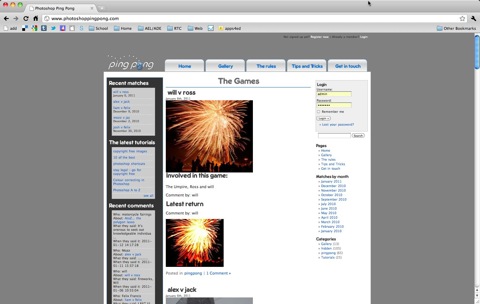
photoshoppingong.com is a wordpress site that I have built in collaboration with the expert programming skills of a ‘parent’ Mathan Mcgurl. Anyone is free to register on the site, find a partner against whom to play, and send in an image in to get a game started. If you register, please also write a bit about who you are, and why you want to joint up, so that I can verify that you are not a bot. I am happy to host games between students.
Some of the work that students have already created on this site is stunning, and playing the games does becomes addictive... students can continue in their own time, taking the activity out of the constraints of the classroom.
Two things that I have learned through this experiment which I had not anticipated - one is the way in which the game becomes a narrative, the images tell a story, the other came through the adding a flash movie that takes the still images and morphs them into a moving image - we have created a new art form, which can only be digital. It reminds me of a Bill Viola or Sam Taylor Wood. Some of the movies are stunning. My favourite at the moment is Jack v Tom - in the gallery section - two 13 year old boys.
The historical precedence for this game is firmly rooted both in the Surrealist game of ‘Cadavre Exquis’ or ‘Exquisite Corpse’ aka Consequences, and in much of the art of the 20c, from Picasso’s early collages, through the work of artists such as George Groz, Hannah Hoch, John Hearfield, and Roland Penrose though the innovative and ongoing work of Richard Hamilton, to contemporary digital photomontage artists such as Peter Kennard and Sean Hillen.
With the ipad, and the other tablet computers that will to be hitting the market now in droves, there is a new opportunity for digital dialogues, using a combination of painting apps and photo manipulation. With touch sensitivity, the pixels in photographic content can be spread like paint, distorted, manipulated, layered, combined with hand (well finger) drawn marks. It is a very exciting time to be a digital artist. Add the compulsion of the game, the ease of the paint and photo programmes, the growing collection of cc licensed images to grab, camera phones, possibilities for creative use of scanners, the nature of the digital environment to build up collections of original images, and the ease with which digital devices enable collaboration - it is a very potent mix.
The experience that I have in my classroom is that of total engagement - students come in, get the devices, and get playing (and learning).
I have written up some thoughts on art, education and play on my MA website here - http://www.rosswallisma.org/extendedpracticejournal/page8/page11/page25/page25.html
Some further thoughts Cadavre Exquis here - http://www.rosswallisma.org/extendedpracticejournal/page13/page5/page5.html
And there is an excellent book recently published by Thames and Hudson - http://www.thamesandhudsonusa.com/new/spring06/528609.htm
A list of links to established artists here in the menu above.
